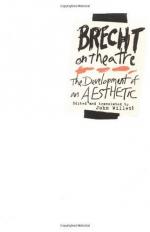
|
| Name: _________________________ | Period: ___________________ |
This test consists of 15 multiple choice questions and 5 short answer questions.
Multiple Choice Questions
1. What does the word 'Spass' mean in German?
(a) Long.
(b) Fun.
(c) Classical.
(d) Free.
2. Lehrstucke are Brecht's _____ works.
(a) Culinary.
(b) Historical.
(c) Holistic.
(d) Didactic.
3. Brecht says actors should act for an audience of _____.
(a) The scientific age.
(b) One.
(c) Diplomats.
(d) The classical era.
4. Elisabeth Begner and Rudolf Forster starred in Shaw's _____ in 1924.
(a) Man and Superman.
(b) Widowers' Houses.
(c) Saint Joan.
(d) Major Barbara.
5. Where did Piscator go 'gloomily' off to to make films after he staged Section 218?
(a) Moscow.
(b) Paris.
(c) London.
(d) Hollywood.
6. Where was Die Asthetschen Anschauungen Berthold Brechts published?
(a) Munich.
(b) Copenhagen.
(c) Moscow.
(d) Frankfurt.
7. In "Last Stage: Oedipus", Brecht says that the future of Germany's theatre is _____.
(a) Non-existent.
(b) Tragic.
(c) Religious.
(d) Philosophical.
8. What does Brecht call people who came to the theatre to get their cockles warmed in "Conversations with Bert Brecht"?
(a) Nobility.
(b) Scum.
(c) Pot ash.
(d) Vegetation.
9. What is the Marxist phrase for the whole body of art, ideas, and morality of any given society?
(a) Brain circus.
(b) Social inherent tendencies.
(c) Ideological superstructure.
(d) Cohesive collective thought.
10. What example does Brecht use to explain his concept of art following reality in "On Form and Subject Matter"?
(a) Sausage.
(b) Pine tree sap.
(c) Petroleum spirits.
(d) French perfume.
11. What does Brecht call the new style of acting that happened as a result of the Threepenny Opera?
(a) Emotive.
(b) The epic style.
(c) Baconian.
(d) Neo-Shakespearean.
12. How did Brecht characterize Shaw's work in "A Catching Infection: Fun"?
(a) As extraordinarily healthy.
(b) As addictively engrossing.
(c) As tediously pedantic.
(d) As ego-driven.
13. Who were Brecht's Frankfurt publishers?
(a) Suhrkamp-Verlag.
(b) Breitkopf Hartel.
(c) Schoenhofs.
(d) Hartel-Verlag.
14. Brecht states that opera cannot be wished away and its _____ have an important social function.
(a) Morals.
(b) Emotions.
(c) Truths.
(d) Illusions.
15. From the pseudo-classical German point of view, the first prison scene in the Threepenny Opera is a/an _____.
(a) Major event.
(b) Diversion.
(c) Plot point.
(d) Establishing scene.
Short Answer Questions
1. Which aspect of epic theatre enlightened the spectator about facts unknown to him?
2. In one of Brecht's examples of how projections were used, projections of warships being launched were running while two characters were fighting over _____.
3. Brecht states in "On Form and Subject Matter" that difficulties are not mastered by _____.
4. _____ is a collection of Brecht's theoretical writings published by Surhkamp.
5. Who starred in City Lights?
|
This section contains 392 words (approx. 2 pages at 300 words per page) |

|




